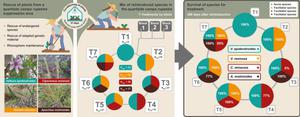Plant and Soil ( IF 3.9 ) Pub Date : 2024-11-06 , DOI: 10.1007/s11104-024-07036-4 Aline Cristina Carvalho, Israel Marinho Pereira, Anderson Oliveira de Lima, José Cola Zanuncio, André Rodrigo Rech, Walisson Kenedy-Siqueira, Geraldo Wilson Fernandes

|
Background and aims
Campo rupestre is an ecosystem in the Espinhaço Mountain Range with high species richness and endemism. The tolerance of Vellozia epidendroides, predominant in this ecosystem, to dehydration seems to facilitate the survival of other plant species. Hence, the importance of V. epidendroides in ecological restoration projects is high. The objective of this study was to evaluate the survival and ecophysiological vegetative performance of V. epidendroides associated with other native species - Apochloa molinioides (Poaceae), Cipocereus minensis (Cactaceae), and Vellozia resinosa (Velloziaceae) - in a project to rescue and reintroduce plants in an area of campo rupestre.
Methods
Vellozia epidendroides was reintroduced isolated or as the main plant in seven combinations of intercrops with the three other species (seven treatments), randomized in three blocks. V. epidendroides (T1), V. epidendroides + V. resinosa (T2), V. epidendroides + C. minensis + A. molinioides (T3), V. epidendroides + C. minensis (T4), V. epidendroides + V. resinosa + C. minensis (T5), V. epidendroides + V. resinosa + A. molinioides (T6), V. epidendroides + V. resinosa + C. minensis + A. molinioides (T7).
Results
Overall (all treatments), the survival of V. epidendroides and V. resinosa was 100% and that of C. minensis was 58.3%. The survival of V. epidendroides + C. minensis + A. molinioides, together, was the lowest (66.67%), with all plants of C. minensis dying after 365 days of planting. Shoot emergence was the only ecophysiological performance parameter that varied among treatments, with the highest value for V. epidendroides in T7 when associated with the other three species; V. resinosa associated to V. epidendroides, and C. minensis in the treatment with all four species.
Conclusion
The reintroduction of species is feasible with V. epidendroides as a companion plant in the reintroduction with the other species, A. molinioides, C. minensis, and V. resinosa, in quartzite areas of campo rupestre.
Graphical abstract
中文翻译:

在 campos rupestres 石英岩区的生态恢复计划中重新引入本地物种
背景和目标
Campo rupestre 是 Espinhaço 山脉的一个生态系统,物种丰富度高,具有特有性。在这个生态系统中占主导地位的 Vellozia epidendroides 对脱水的耐受性似乎促进了其他植物物种的生存。因此,V. epidendroides 在生态恢复项目中的重要性很高。本研究的目的是评估与其他本地物种 - Apochloa molinioides (禾本科)、Cipocereus minensis (仙人掌科) 和 Vellozia resinosa (Velloziaceae) 相关的 V. epidendroides 的生存和生态生理营养性能 - 在一个拯救和重新引入 Campo rupestre 地区的植物的项目中。
方法
Vellozia epidendroides 被孤立地或作为主要植物重新引入,与其他三个物种 (7 个处理) 的 7 种间作组合,随机分为 3 个区组。表枝草 (T1), 表枝草 + 树脂枝草 (T2), 表枝草 + 褐枝杆菌 + 褐枝杆菌 (T3), 表枝草 + 褐枝杆菌 (T4), 表枝草 + 树脂枝草 + 褐枝草 (T5), 表枝草 + 树脂枝草 + 褐枝草 (T6), 表枝草 + 树脂枝草 + 褐枝杆菌 + 枝状A. molinioides (T7).
结果
总体 (所有处理),表突念弧菌和树脂弧菌的存活率为 100%,C. minensis 的存活率为 58.3%。表突菩萨 + 小苔藓 + 小荫蚜合体存活率最低 (66.67%),所有植株在种植 365 天后死亡。芽出苗是唯一因处理而异的生理生态性能参数,当与其他三个物种相关时,T7 中的 V. epidendroides 值最高;V. resinosa 与 V.epidendroides 和 C. minensis 相关,在所有四个物种的处理中。
结论
在 campo rupestre 的石英岩地区,以 V. epidendroides 作为伴侣植物重新引入物种是可行的,与其他物种 A. molinioides、C. minensis 和 V. resinosa 一起重新引入。


















































 京公网安备 11010802027423号
京公网安备 11010802027423号